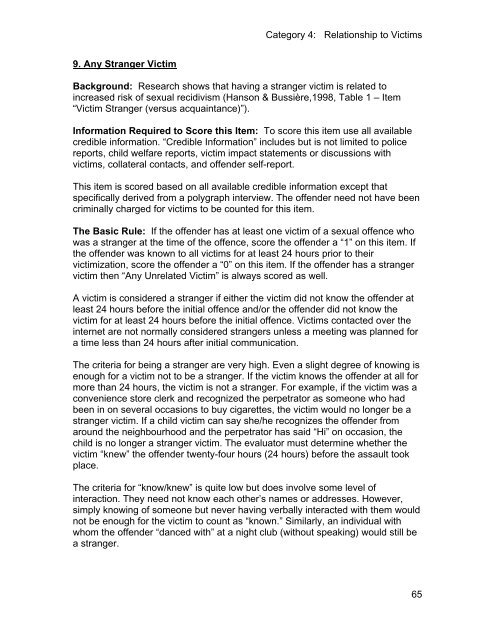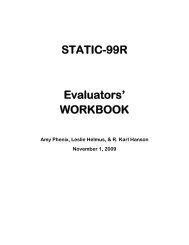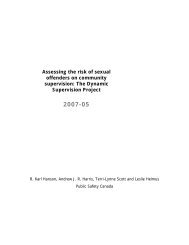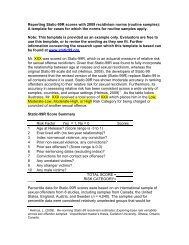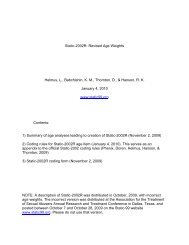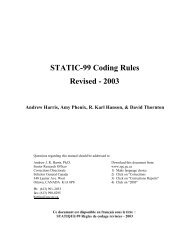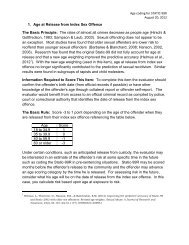Static-2002 coding rules (2009) - Static-99
Static-2002 coding rules (2009) - Static-99
Static-2002 coding rules (2009) - Static-99
Create successful ePaper yourself
Turn your PDF publications into a flip-book with our unique Google optimized e-Paper software.
Category 4: Relationship to Victims<br />
9. Any Stranger Victim<br />
Background: Research shows that having a stranger victim is related to<br />
increased risk of sexual recidivism (Hanson & Bussière,1<strong>99</strong>8, Table 1 – Item<br />
“Victim Stranger (versus acquaintance)”).<br />
Information Required to Score this Item: To score this item use all available<br />
credible information. “Credible Information” includes but is not limited to police<br />
reports, child welfare reports, victim impact statements or discussions with<br />
victims, collateral contacts, and offender self-report.<br />
This item is scored based on all available credible information except that<br />
specifically derived from a polygraph interview. The offender need not have been<br />
criminally charged for victims to be counted for this item.<br />
The Basic Rule: If the offender has at least one victim of a sexual offence who<br />
was a stranger at the time of the offence, score the offender a “1” on this item. If<br />
the offender was known to all victims for at least 24 hours prior to their<br />
victimization, score the offender a “0” on this item. If the offender has a stranger<br />
victim then “Any Unrelated Victim” is always scored as well.<br />
A victim is considered a stranger if either the victim did not know the offender at<br />
least 24 hours before the initial offence and/or the offender did not know the<br />
victim for at least 24 hours before the initial offence. Victims contacted over the<br />
internet are not normally considered strangers unless a meeting was planned for<br />
a time less than 24 hours after initial communication.<br />
The criteria for being a stranger are very high. Even a slight degree of knowing is<br />
enough for a victim not to be a stranger. If the victim knows the offender at all for<br />
more than 24 hours, the victim is not a stranger. For example, if the victim was a<br />
convenience store clerk and recognized the perpetrator as someone who had<br />
been in on several occasions to buy cigarettes, the victim would no longer be a<br />
stranger victim. If a child victim can say she/he recognizes the offender from<br />
around the neighbourhood and the perpetrator has said “Hi” on occasion, the<br />
child is no longer a stranger victim. The evaluator must determine whether the<br />
victim “knew” the offender twenty-four hours (24 hours) before the assault took<br />
place.<br />
The criteria for “know/knew” is quite low but does involve some level of<br />
interaction. They need not know each other’s names or addresses. However,<br />
simply knowing of someone but never having verbally interacted with them would<br />
not be enough for the victim to count as “known.” Similarly, an individual with<br />
whom the offender “danced with” at a night club (without speaking) would still be<br />
a stranger.<br />
65


